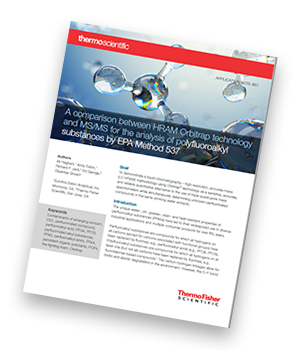This application note provides a comparison between HRAM Orbitrap technology and MS/MS for the analysis of polyfluoroalkyl substances (PFASs) by EPA Method 537.
 Goal
Goal
To demonstrate a liquid chromatography – high-resolution, accurate-mass (LC-HRAM) methodology using Orbitrap™ technology as a sensitive, accurate, and reliable quantitative alternative to the use of triple quadrupole mass spectrometers while simultaneously determining unknown perfluorinated compounds in the same drinking water extracts.
Introduction
The unique water-, oil-, grease-, stain- and heat-resistant properties of perfluoroalkyl substances (PFASs) have led to their widespread use in diverse industrial applications and multiple consumer products for over fifty years.
The National Institute of Environmental Health Sciences and the National Toxicology Program are supporting research to better understand the potential health effects in humans of exposure to PFASs. In animal studies, some PFASs disrupt normal endocrine activity; reduce immune function; cause adverse effects on multiple organs, including the liver and pancreas; and cause developmental problems in rodent offspring exposed in the womb.
As a result, the United States Environmental Protection Agency (EPA) developed EPA Method 537 for the Unregulated Contaminant Monitoring Rule (UCMR 3) program, which collects data for contaminants suspected to be present in drinking water but that do not currently have health-based standards set under the Safe Drinking Water Act (SDWA).
Liquid chromatography-tandem mass spectrometry (LC/MS/MS) has been the method of choice for
the analysis of PFASs in a variety of matrices. EPA Method 537 is based on this technique, as it allows
monitoring of select target analytes in public water supplies. However, other screening strategies taking
into account full scan with other advanced MS/MS scan modes can potentially offer a valuable alternative to SRM based methodology due to the development of selective instrumentation for the simultaneous determination of known and unknown contaminants. In addition, high resolution, accurate-mass (HRAM) capability also provides the ruggedness and sensitivity of MS/MS-based methods without the limitations of unknown identification.
For this application, HRAM Orbitrap quantitation and sensitivity on the Thermo Scientific™ Q Exactive™ mass spectrometer is evaluated using EPA Method 537 with some minor changes to expand the scope of compounds that can be analysed using the method. A comparison of HRAM Orbitrap and triple quadrupole mass spectrometry is described in terms of lowest concentration minimum reporting limit (LCMRL) for the six PFAS compounds in the current EPA Method 537.
Experimental
Full experimental conditions can be found in the application note.
Results and discussion
The liquid chromatography parameters were optimized to ensure good peak symmetry, especially for the early eluting compounds. As the homologous CF2 backbone increases, the compounds become less polar, exhibiting greater retention on the reversed-phase column. The sulfonates are less ionic than those compounds containing carboxylic acids, hence they elute later than PFCA with equal number of carbon atoms in the backbone. For example, PFOS elutes later than PFOA, although both are C8.
The sensitivity and linearity for the target compounds on the Q Exactive HRAM Orbitrap mass spectrometer
in both the full scan and PRM acquisitions were compared.
Conclusion
Based on the EPA method flexibility rule, QA/QC requirements and guidance within EPA Method 537, HRAM Orbitrap technology should be permissible for potential compliance monitoring if PFASs become regulated compounds in US drinking waters. Q Exactive HRAM Orbitrap instrumentation in the PRM scan mode can be used for quantitation with performance like a triple quadrupole in SRM mode with added specificity, selectivity, and comparable sensitivity.
HRAM Orbitrap technology is shown to provide equal or better quantitation in full scan as compared to traditional triple quadrupole techniques, with the additional capability to screen for unknown PFASs.




